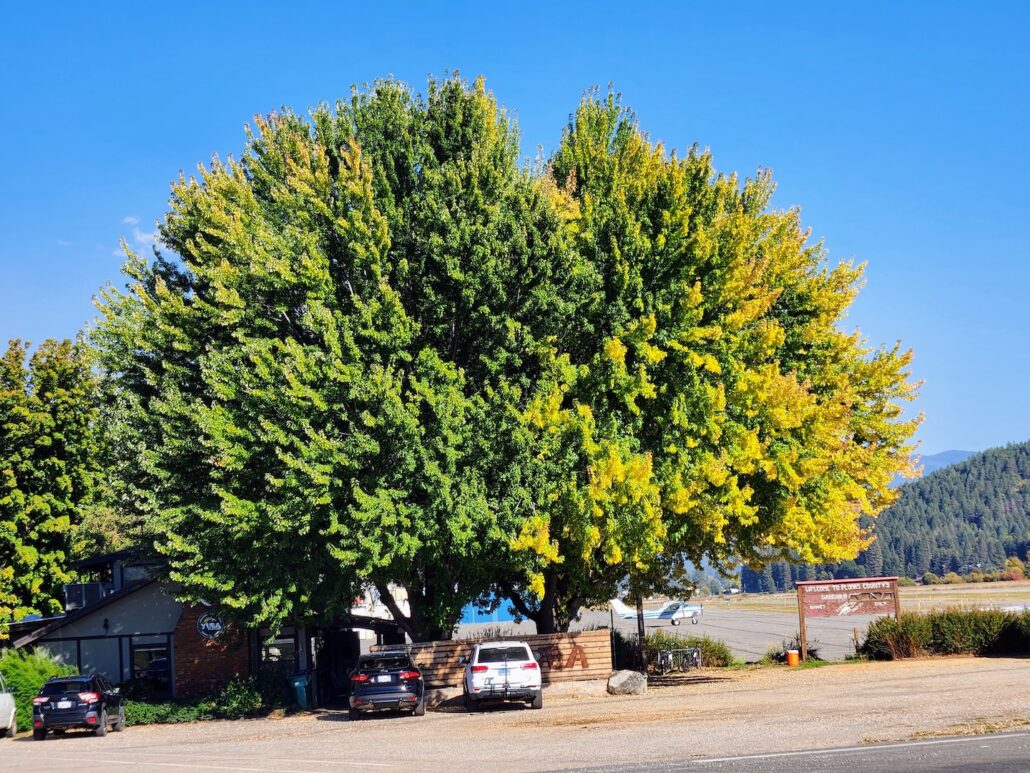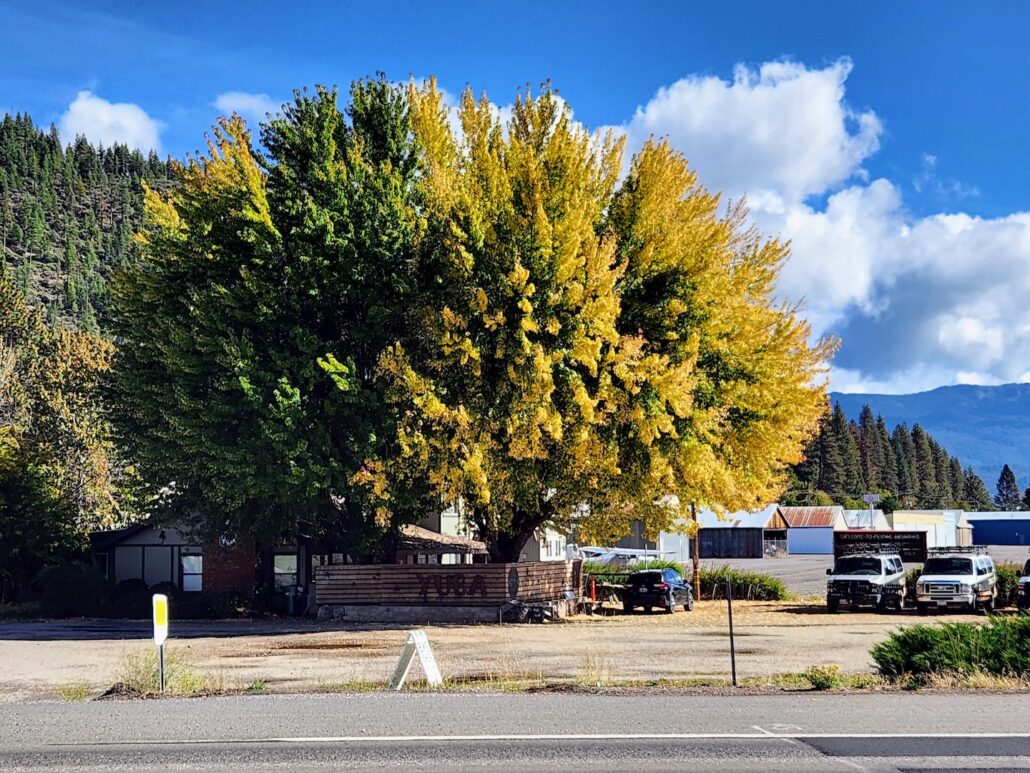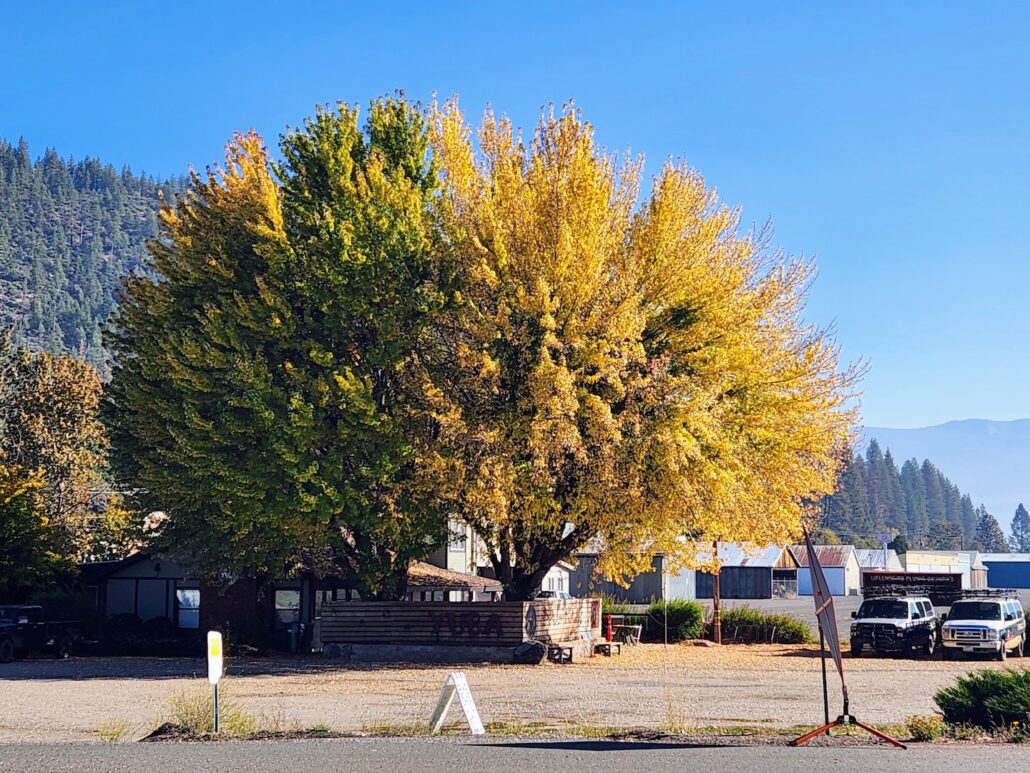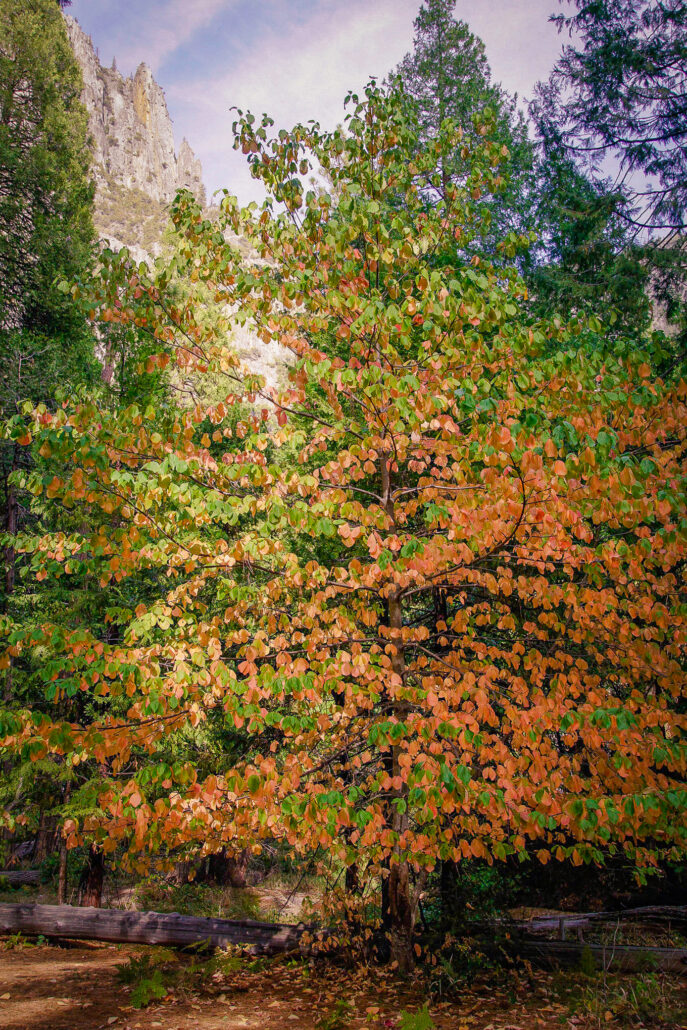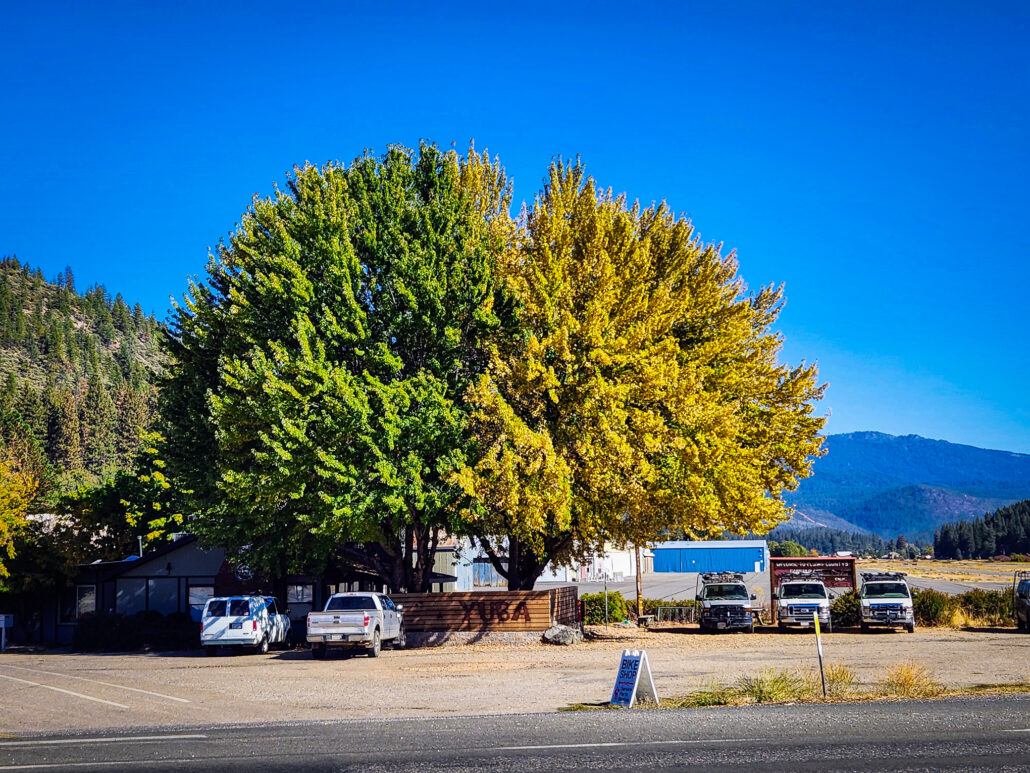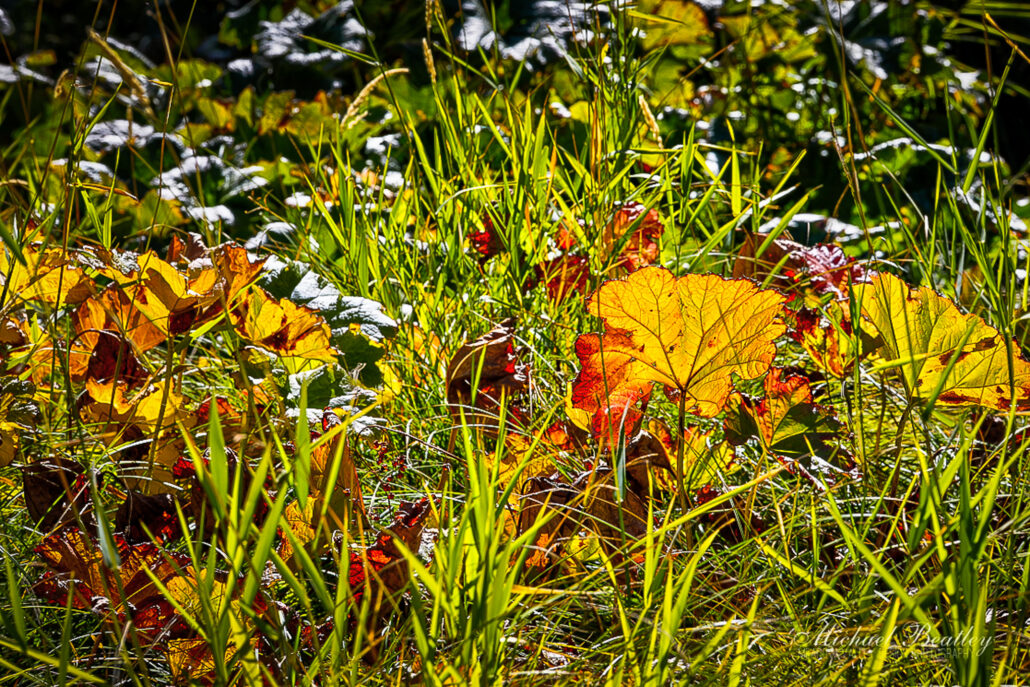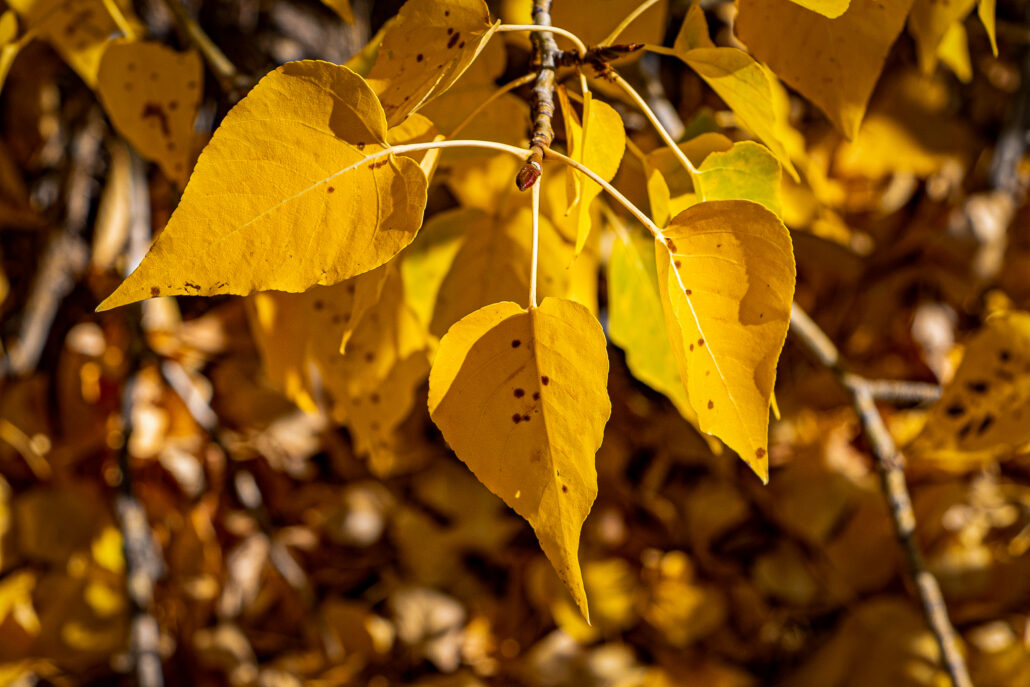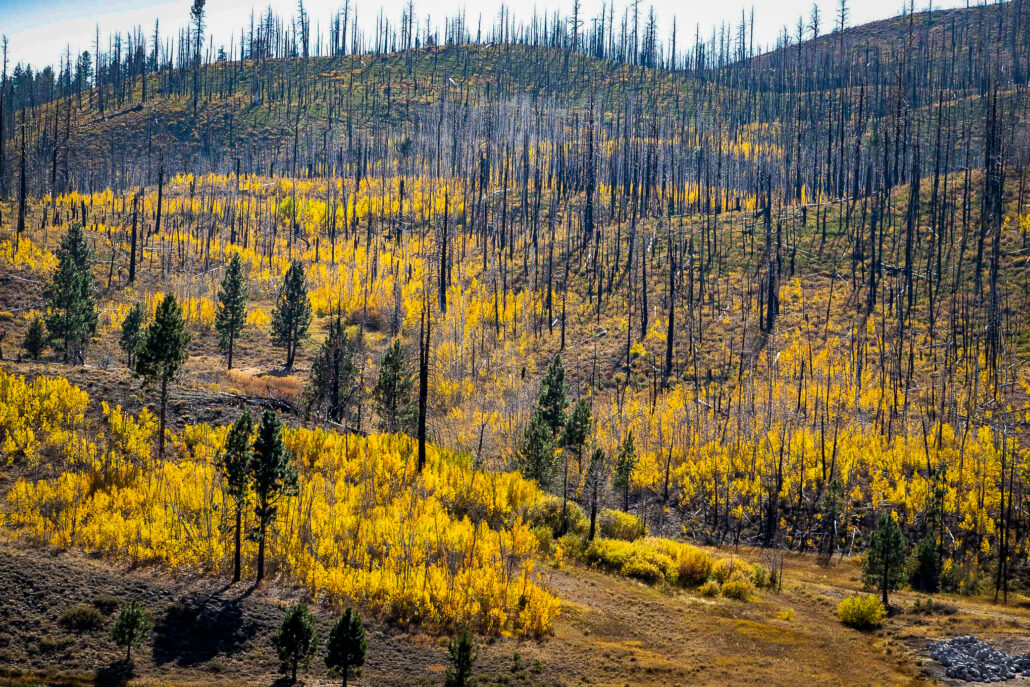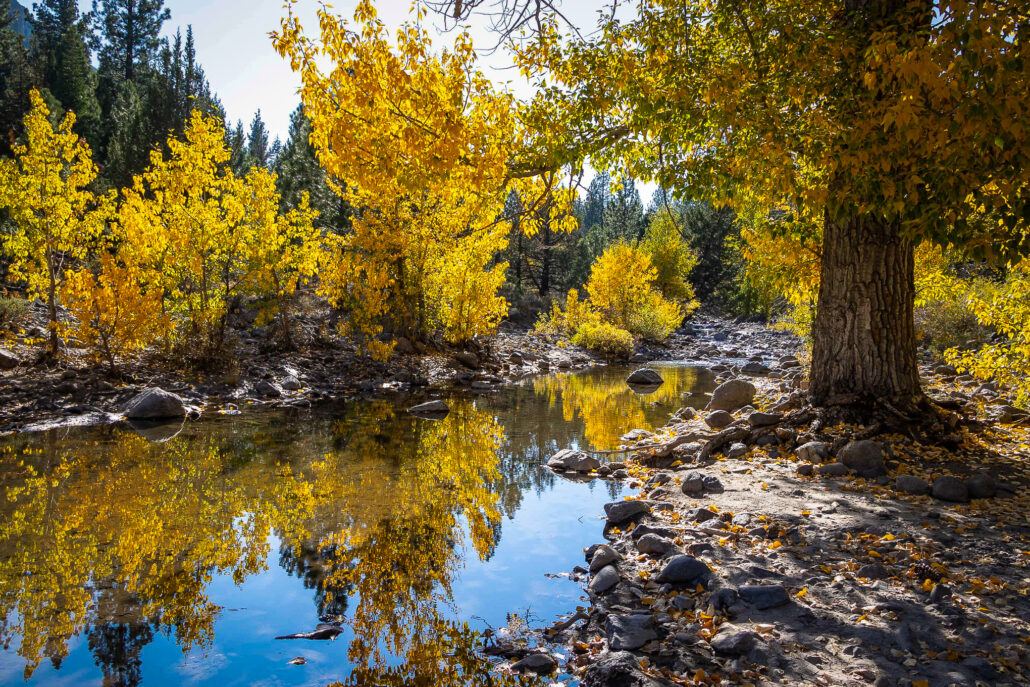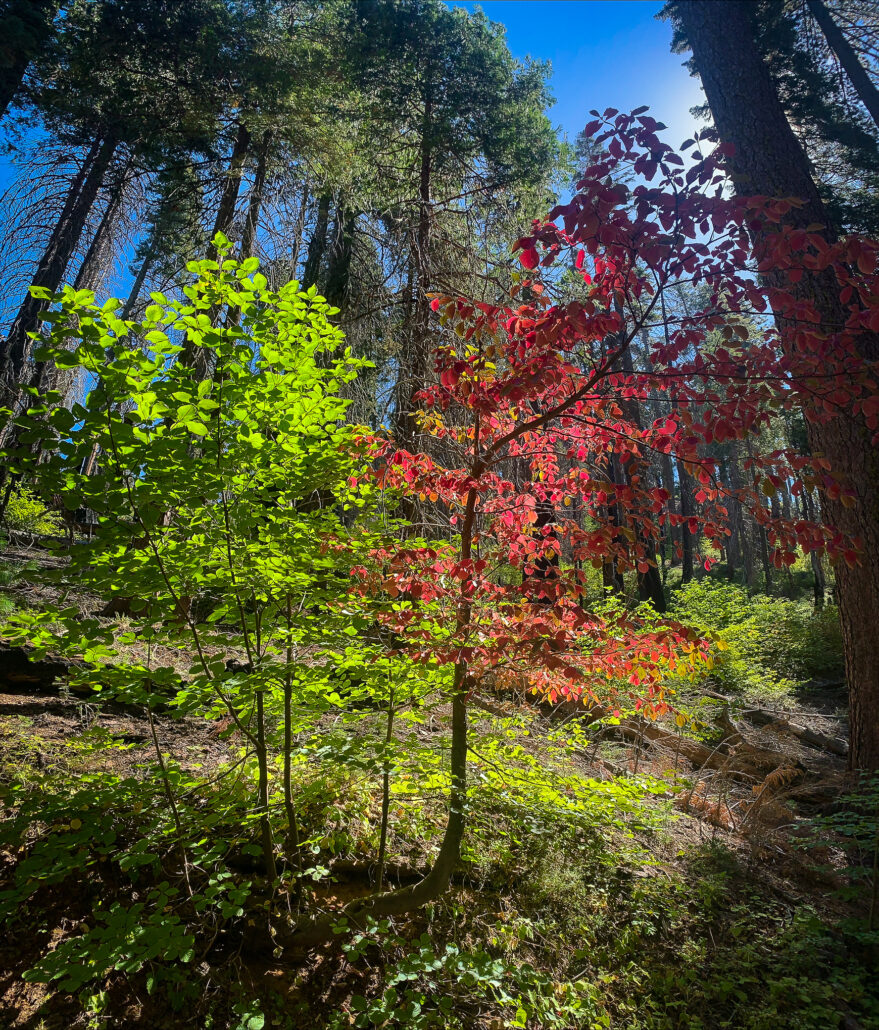Meteorological Fall, Plus Why Leaves Change
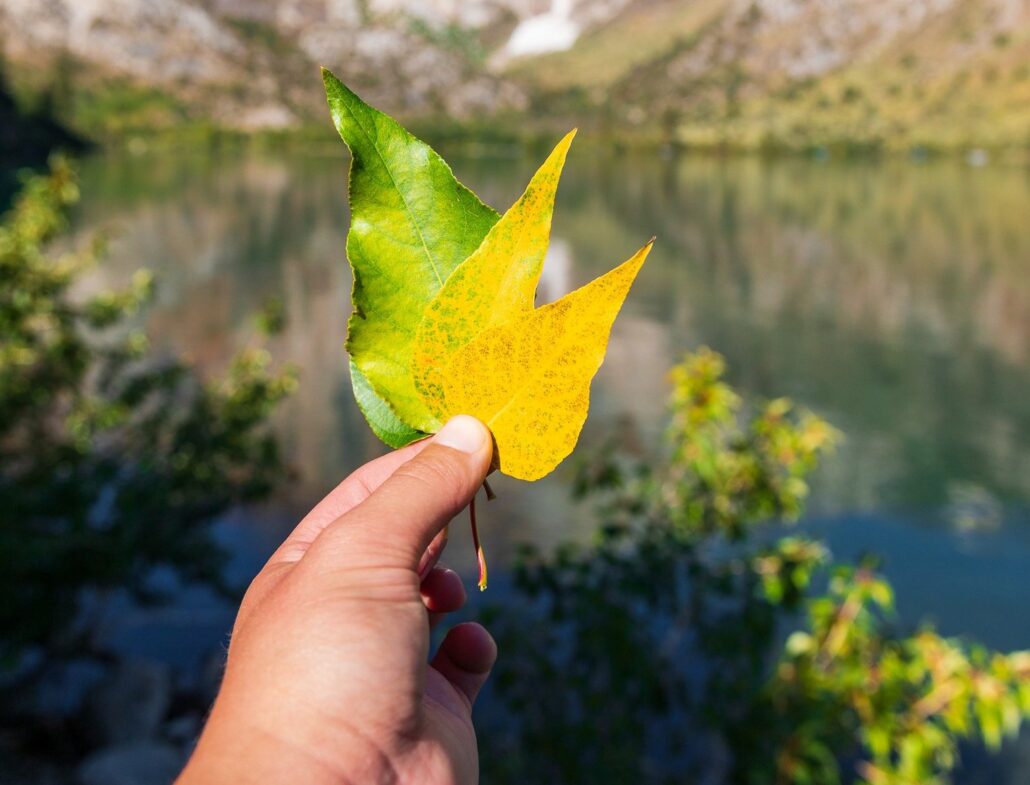
Color spotter, Samantha Lindberg recently used the phrase “meteorological fall” and it peaked my interest. After doing a little research it seems the term refers to a season created by scientists (meteorologists). It begins September 1 and ends November 30, according to wane.com, because this is the time period that the general public associates with “fall.”
While the date of the actual autumn equinox changes every year, meteorological fall stays the same. The equinox arrives on September 22 in 2023 in California, but with cooler temperatures in the state this Labor Day Weekend, perhaps the scientists behind meteorological fall are on to something.
Either way, the reason leaves change color throughout the season stays the same. Blake Engelhardt with the US Forest Service explains.
“During the summer growing season the leaves are constantly producing chlorophyll, which gives them their green color,” she says. “In the fall, longer nights trigger the formation of the abscission layer.”
According to Engelhardt, this is basically a thickened layer of cells at the base of the leaf where it attaches to the stem that blocks the transport of water and sugar into the leaf.
“Thin, deciduous leaves won’t survive the freezing temperatures of winter, so there’s no reason to keep feeding them,” she adds. “Once chlorophyll synthesis stops, the green quickly disappears and other more persistent pigments become visible yellows, reds, purples.”
Yellow comes from Xanthophylls (compounds) and Flavonols (proteins) that reflect yellow light.
Orange is found in leaves with lots of beta-carotene, a compound that absorbs blue and green light and reflects yellow and red light, giving the leaves their orange color.
Red comes from the Anthocyanin compound.
The best fall color occurs when days are warm and nights are clear and cold. California’s cloudless skies and extreme range of elevations (sea level to 14,000′) provide ideal conditions for the development of consistently vivid fall color, as seen in these reports.
Peak fall color will begin appearing in the Eastern Sierra above 9,000 feet (you can drive right to it) during the last two weeks of September.
Upcoming Fall Events
In addition to fabulous fall colors, the season also offers up great events.
In Inyo County, the Blake Jones Trout Derby was rescheduled for Sept. 16 and the Millpond Music Festival is that same weekend: Sept. 15-17.
Tree City USA
Among its claims to fame, Davis has been named a “Tree City, USA”.
This distinction is awarded by the National Arbor Day Foundation to municipalities that:
- Have a tree board or department,
- Have established a community ordnance for tree care,
- Have a forestry program that invests at least $2 million annually, and that
- Observe Arbor Day.
Other California cities so designated, include:
- Alhambra,
- Anaheim,
- Bakersfield,
- Beverly Hills,
- Brentwood,
- Burbank,
- Calabasas,
- Cerritos,
- Chico,
- Claremont,
- Coronado,
- Corona,
- Costa Mesa,
- Fremont,
- Fullerton,
- Gilroy,
- Hayward,
- Hemet,
- Irvine,
- Lakewood,
- Lodi,
- Los Angeles,
- Martinez,
- Menlo Park,
- Merced,
- Mission Viejo,
- Modesto,
- Napa,
- Oakland,
- Orange,
- Pasadena,
- Poway,
- Sacramento,
- St. Helena,
- San Dimas,
- San Fernando,
- San Francisco,
- San Jose,
- San Leandro,
- San Ramon,
- Santa Clara,
- Santa Clarita,
- Saratoga,
- Santee,
- South Pasadena,
- Upland, and
- Woodland.
On a morning walk through Davis, local color spotter Philip Reedy captured images that show why his town is deserving of the honor. To see how Davis informs its residents what trees to plant, CLICK HERE.
Beauty Berries
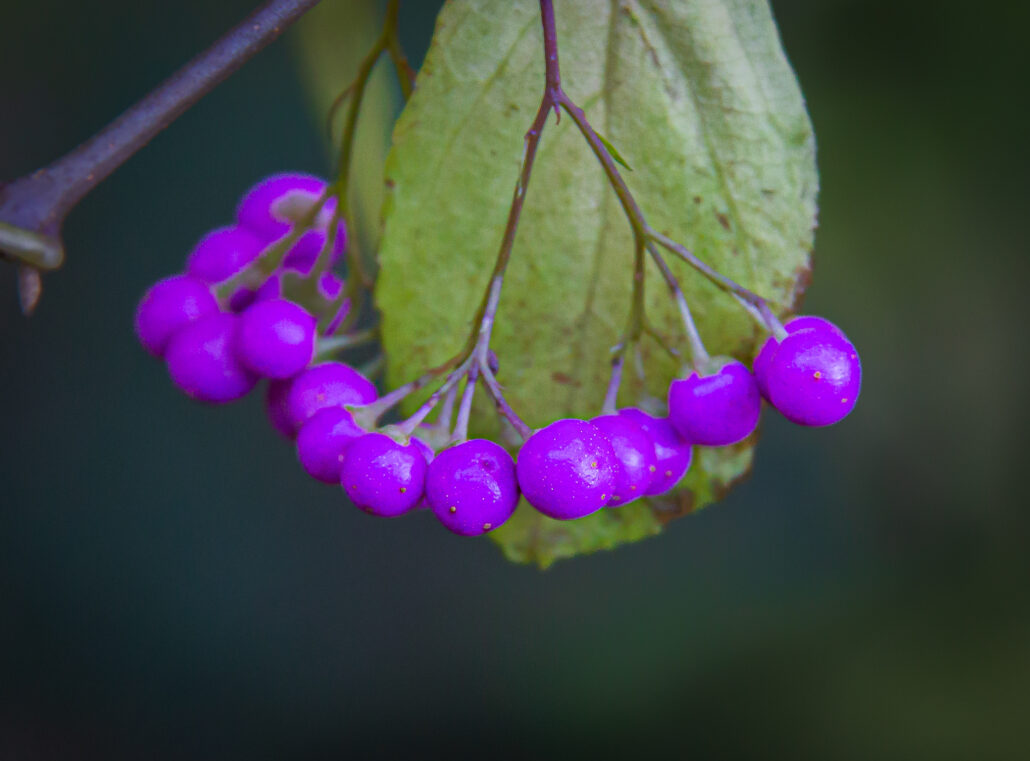
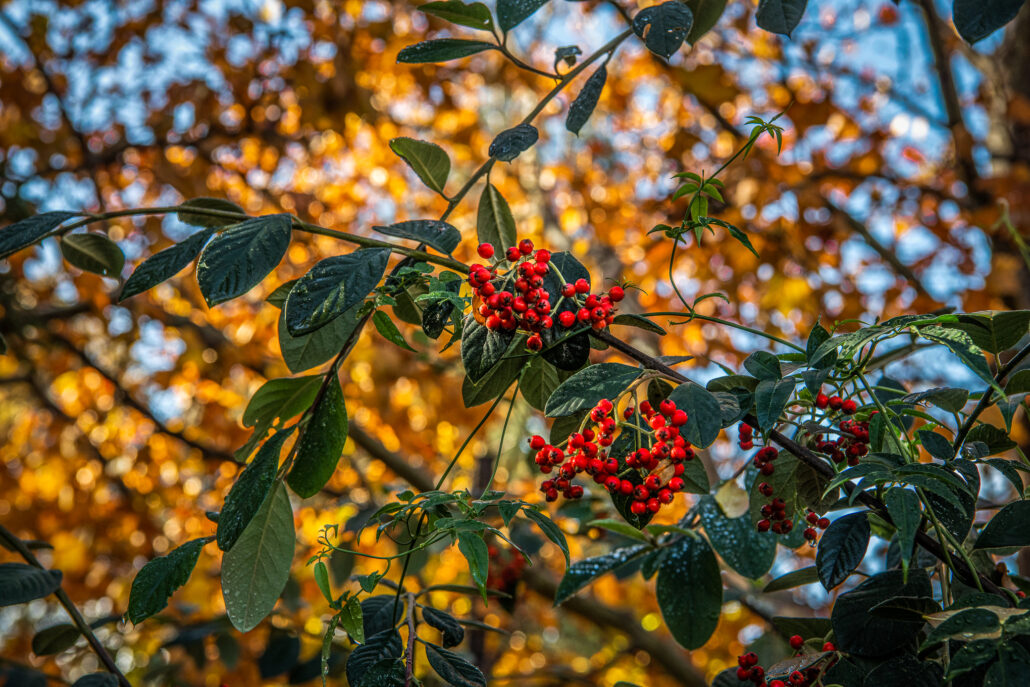
Naturalist Sandy Steinman and outdoor photographer Philip Reedy just know what gifts to give during December … beauty berries.
In Sandy’s case, his gift included images of American Beautyberry (Callicarpus americana) and in Philip’s the Toyon (Heteromeles arbutifolia). Each plant unwraps vibrant color near the end of autumn.
Beautyberry is native to the southeast U.S., while Toyon is a California native. Beautyberry does best in moist thickets and woods, whereas Toyon thrives in California’s dry climate.
Crushed beautyberry leaves have been used as a folk remedy to prevent mosquito bites and the deep purple berries can be made into an edible jelly. While, Toyon became so popular as a table decoration in the 1920s that Los Angeles passed an ordinance prohibiting collecting it on public land and it got the nickname California holly.
- Toyon -PEAK (75-100%) GO NOW!
- Beautyberry – PEAK (75-100%) GO NOW!
Yosemite Dogwood
There are four types of dogwood native to California: Mountain or Pacific Dogwood, a tree, and three shrubs: brown, red osier and blackfruit dogwood. They all grow on moist lower slopes and in riparian zones.
Cornus nutalli is the tree, best known in Yosemite Valley for its showy, white “flowers” that beautifully decorate the banks of the Merced River each May. These flowers are actually modified leaves, called bracts. Pacific dogwood’s fruit is bright orange-red.
C. glabrata (brown dogwood) is a shrub that forms a dense thicket, rising to 15′. C. sericea (red osier) is a multistemmed shrub similar in size to the brown dogwood, and also has white or blue fruit. C. sessilis (blackfruit dogwood) grows to 10′ and distinctively has brownish-yellow bracts and black fruit. It’s often overlooked because it blooms so early in spring.
On Legarlin Li’s recent visit to Yosemite Valley, the dogwood he captured had vermilion leaves, though Pacific dogwood often show rose, pink and auburn.
An eagle’s eye view of the Valley indicated little to no fall color change, but that’s expected as dogwood and bigleaf maple, which are showing now, are hidden beneath a canopy of conifers.
- Dogwood and Bigleaf Maple, Yosemite Valley (4,000′) – Near Peak (50-75%) Go Now.
50/50 Tree Returns
Autumn colors are sweeping throughout California as green gives way to yellow. After a hot September, temperatures have gotten significantly cooler as days shorten. Sunsets are noticeably earlier and the weather patterns throughout California are transitioning towards winter.
It is these changes that determine how colors develop. Writing for Thought.co, Tiffany Means opines in How Weather Affects Fall Color that a decrease in sunlight causes a reduction in chlorophyll (the green pigment in leaves) which in turn produces the vibrancy that California is known for.
Due to California’s vast range of climates, fall color usually starts in the Sierra and moves westward towards the coast with each passing week, however, microclimates and varying local conditions can cause fall color to greatly differ in a very small area.
Jeff Luke Titcomb demonstrates a mind-blowing example of this in Quincy, where two maples are growing side-by-side.
The pair serve as a beautiful contrast between summer and fall with one tree still fully green, and the other at peak. To see this phenomenon, visit the Quincy Airport in Plumas County now, as this show will only last a few days more.
- 50/50 Tree, Quincy Airport (3,342′) – Just Starting to PEAK (0-100%) GO NOW!
Indian Rhubarb – Near Peak
Indian Rhubarb (Darmera) is the northern Sierra’s signature fall color plant. At peak, its large, fan-shaped leaves turn shades of blood red, apricot, magenta, saffron, viridian and gold. They hang over streams in such profuse perfection that they appear to have been landscaped.
Plumas County color spotter Michael Beatley checked on the status of the Darmera at Oakland Camp, yesterday.
Oakland Camp is a summer camp operated by the City of Oakland for its children. Oakland Camp Road, a public access road near Quincy, passes through the camp skirting Spanish Creek whose banks are lined for several miles with Darmera.
Beatley reports that the rhubarb are Near Peak and should peak within the coming week. He also noted that Oakland Camp Road is lined with hundreds of black oak trees that have turned red, orange and yellow, providing colorful surroundings for a setting that should explode in color within the week.
- Oakland Camp, Spanish Creek (5,817′) – Near Peak (50-75%) Go Now.
Black and Quaking
The deeply golden spear tips seen above are near perfect examples of peak Black cottonwood. Mark Hoshovsky photographed them at the Silver Mountain Historic Site on Ebbetts Pass (CA 4) in Alpine County.
Black cottonwood have a spear-shaped leaf and rounded stem, whereas Frémont cottonwood leaves are broader, have a scalloped edge and a flat stem. Black cottonwood grow mostly above 7,000′ whereas Frémont cottonwood are usually found growing below 6,000′. With these guidelines, it’s easy to tell them apart.
Discerning the differences between cottonwood and aspen is even easier, though the two are often mistaken.
Quaking aspen leaves are smaller, more rounded and mostly yellow, though also can be golden, orange or red. The trunks are radically different, Aspen trunks are smooth and white or green. Cottonwood are brown and rough. Cottonwood and aspen both thrive near water sources, though aspen like smaller creeks, while cottonwood prefer bigger streams.
On Hoshovsky’s drive from the East Fork of the Carson River, along Monitor Pass and past Heenan Lake, he passed the burn scar from the 2015 Washington Fire. The conifers are nearly all gone, but willows and aspen are thriving in the sunlight and promise to provide an increasingly spectacular display for decades to come.
- Ebbetts Pass (8,730′) – PEAK (75-100%) GO NOW!
- Monitor Pass (8,314′) – PEAK (75-100%) GO NOW!
Identifiable by its Bark
It’s said the dogwood is most identifiable by its bark.
Aside from that being a corny cornus nutalli joke, it’s untrue. In California, Pacific dogwood is best identified in autumn by its red, rose or pink leaves and ruddy branches which hang heavy with orange-crimson drupes. In spring, it is appreciated for its showy white to pinkish bracts that decorate the tree’s freshly green boughs.
Yes, when it comes to an entertaining display, a dogwood’s foliage is what matters. Anything else is barking up the wrong tree.
Why don’t evergreens lose their leaves?
Actually, they do. It just doesn’t happen all at once, with few exceptions.
Evergreen trees have both broad leafs and needles. Madrone, magnolia and photinia are examples of broadleaved evergreens, while pine, fir, cedar, spruce, and redwood have needled leaves.
Evergreen needles can last anywhere from a year to 20 years, but eventually they are replaced by new leaves. When that happens, the old needles turn color and drop, but not all together and not as dramatically as deciduous trees (e.g., maple, oak, dogwood, alder, birch).
The reason needles are green is that they are full of chlorophyll which photosynthesizes sunlight into food for the tree. It also reflects green light waves, making the needles look green.
Needles, just like deciduous leaves, contain carotenoid and anthocyanin pigments. You just don’t see them until the green chlorophyll stops being produced. Once that happens, hidden carotenoids (yellow, orange and brown) emerge, as is seen in the above photograph.
Additionally, red, blue and purple Anthocyanins – produced in autumn from the combination of bright light and and excess sugars in the leaf cells – also emerge once the chlorophyll subsides.
Yes, even evergreen leaves change color… eventually.

